Your next great L.A. meal will probably be a tasting menu
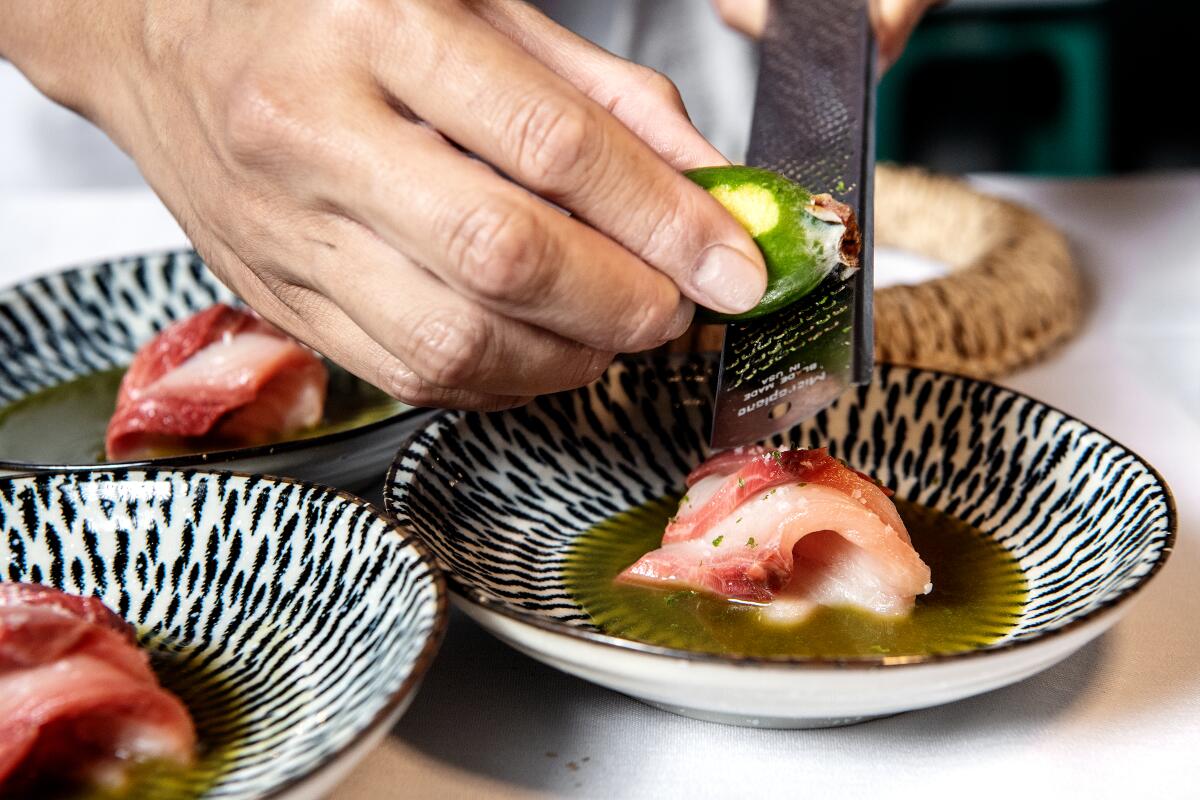
One of the best tasting menus in Los Angeles is served on a folding table, in a dark alley next to a dumpster. Itâs where Justin Pichetrungsi hosts his omakase dinners, behind Anajak Thai, his familyâs Sherman Oaks restaurant. It is the meal I recommend most often to anyone looking for something truly spectacular.
Pichetrungsi and another team member prepare each dish on another folding table, using a portable induction stove. Itâs not a picnic atmosphere, evidenced by the white tablecloths draped atop tables adorned with flickering lights, but the mood can be influenced by random events. Halfway through a recent meal, the tenant who lives in the house behind the restaurant walked through the makeshift dining area and let Pichetrungsi know that heâd be setting off some fireworks just yards away â in about 10 minutes.
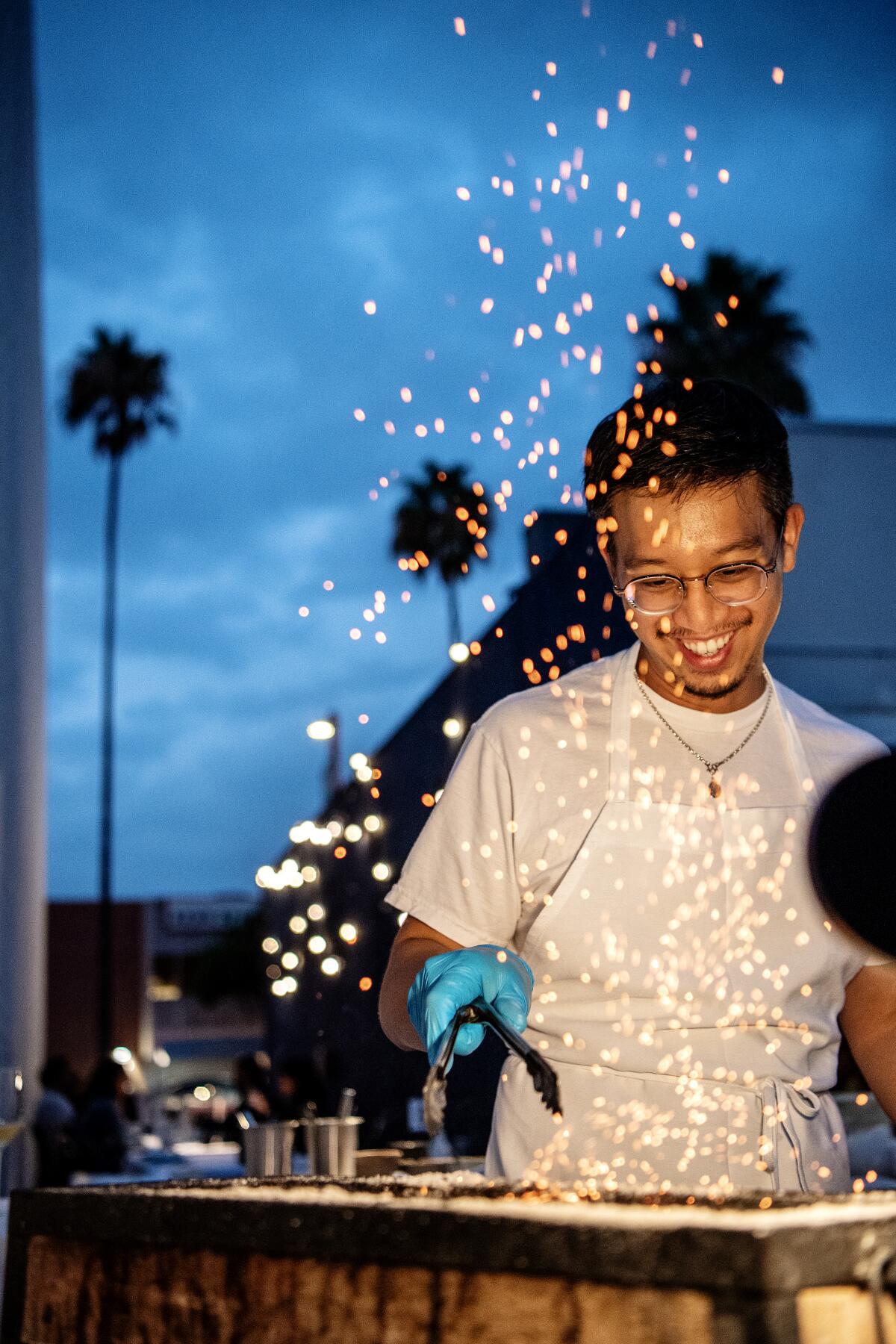
Dinner began with golden pastry cups made from coconut and rice flours and filled with marinated Hokkaido ikura, Santa Barbara uni and peas; they were followed by a procession of ânigiriâ fashioned with aged fish from the Joint Seafood restaurant and fish market in Studio City atop nubs of sticky rice. The dry-aged steelhead salmon sushi was covered in a spoonful of panang curry before it was torched until just cooked and then kissed with a drizzle of Thai basil oil.
Boat-run scallops from Maine floated in a cold coconut soup seasoned with a swirl of chile crisp, lime and pink salt. The grilled A5 wagyu was accompanied by wilted radicchio, sorrel and a fish sauce caramel. There were bowls of khao man gai rice slick with duck fat under plump blue oyster mushrooms marinated in coconut milk and tom yum made from the dry-aged bones of striped bass and garnished with shrimp heads.
âBeing in the alley, itâs kind of a nice metaphor because Thai food is seen so much as street food, but Iâm trying to do a tasting menu on a white table cloth so you have the contrast of all these plates and this tiny delicate food presented in a dumpster alley,â he said. âThere really is a certain level of scrappiness.â
Pichetrungsi launched his $150 omakase menu (called omakase for the 12 years his father, who co-owns Anajak with his wife and son, worked as a sushi chef) in July 2020 . The omakase service is on a brief hiatus and will return in April at $175 per person.
Itâs part of a growing wave of tasting menus that are shifting the traditional format to something more casual and distinctly Los Angeles. The Eurocentric foods and dinner bills that could easily cover a monthâs rent are being replaced by folding tables, â90s rap music and cuisines that span the globe.
These are tasting menus born in the early days of quarantine, the need for a creative outlet, staffing constraints and a cityâs constant appetite for something new.
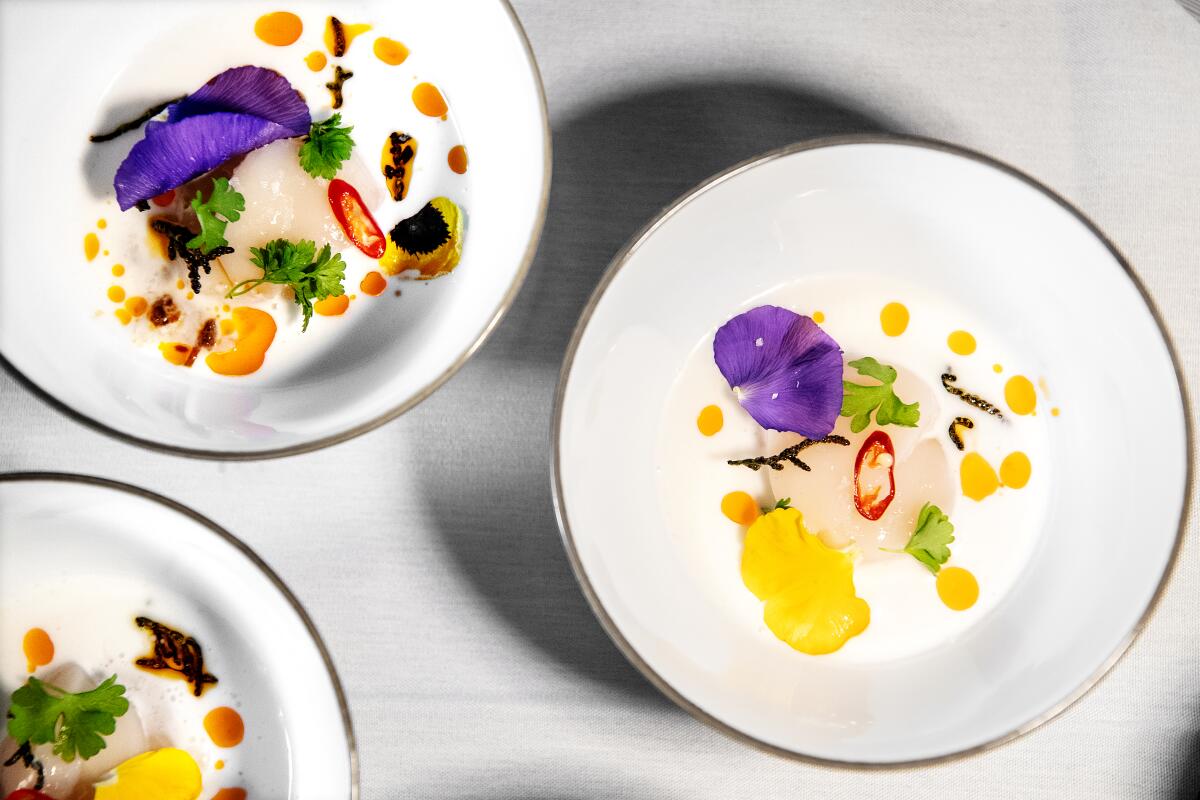
âIâve been thinking a lot about how you define the taste of L.A.,â Pichetrungsi said. âNow itâs completely different than the more traditional MĂŠlisse or Providence style. That was the first wave to allow for the foundation to say, âOh yeah, L.A. has one Michelin or two Michelin stars.ââ But then, he asked, âCool, but now what?â
âNow whatâ is also a nightly tasting menu at a ramen restaurant in Koreatown. What chef Hiroyuki Masato is attempting at Iki Ramen is the ultimate culinary flex. He reserves four tables a night for a procession of nine courses ($105) that incorporate ramen, mazemen enriched with uni or mentaiko, steamed buns overflowing with soft shell crab, handrolls and sashimi. The menu changes every three to four months, but you can count on some variation on all of the above.
In mid-2019, Alex Carrasco opened Bee Taqueria in West Adams with a small menu of tacos, chips and salsa. But Carrasco, who is from Mexico, wanted to do something that would challenge him nightly. About three months after opening, inspired by the tacos at Pujol in Mexico City, Carrasco started to offer a taco omakase in addition to his a la carte menu. As far as he knew, he was the only person in the greater Los Angeles area serving an entire tasting menu of tacos.
Carrasco took reservations for two seatings a night for anywhere from two to 20-plus people. He cooked a $40, five-course meal, all the while servicing his regulars who stopped by for tacos.
âI want to have something that keeps me motivated so that I can play around with ingredients,â Carrasco said. âI was introducing people to stuff from Mexico that was rare to see in Los Angeles.â
Carrasco was excited at the prospect of introducing diners to something theyâd never seen before, and his early tacos were filled with grasshoppers, ants and escamoles. He also makes yellowtail fish tacos with caviar and empanadas with summer truffles. His blue, red and white corn tortillas are made from heirloom Masienda masa. Some he flavors with beets, others he spikes with epazote.
The five courses gradually increased to 10, as diners requested more food. The current omakase starts at $95 with an option to upgrade to an $125 menu with more expensive ingredients such as A5 wagyu, foie gras and caviar.
âI will not say I brought my tacos to the next level because I donât know what that is, but I brought Mexican food in L.A. to my level,â he said. âTo the next level for me.â
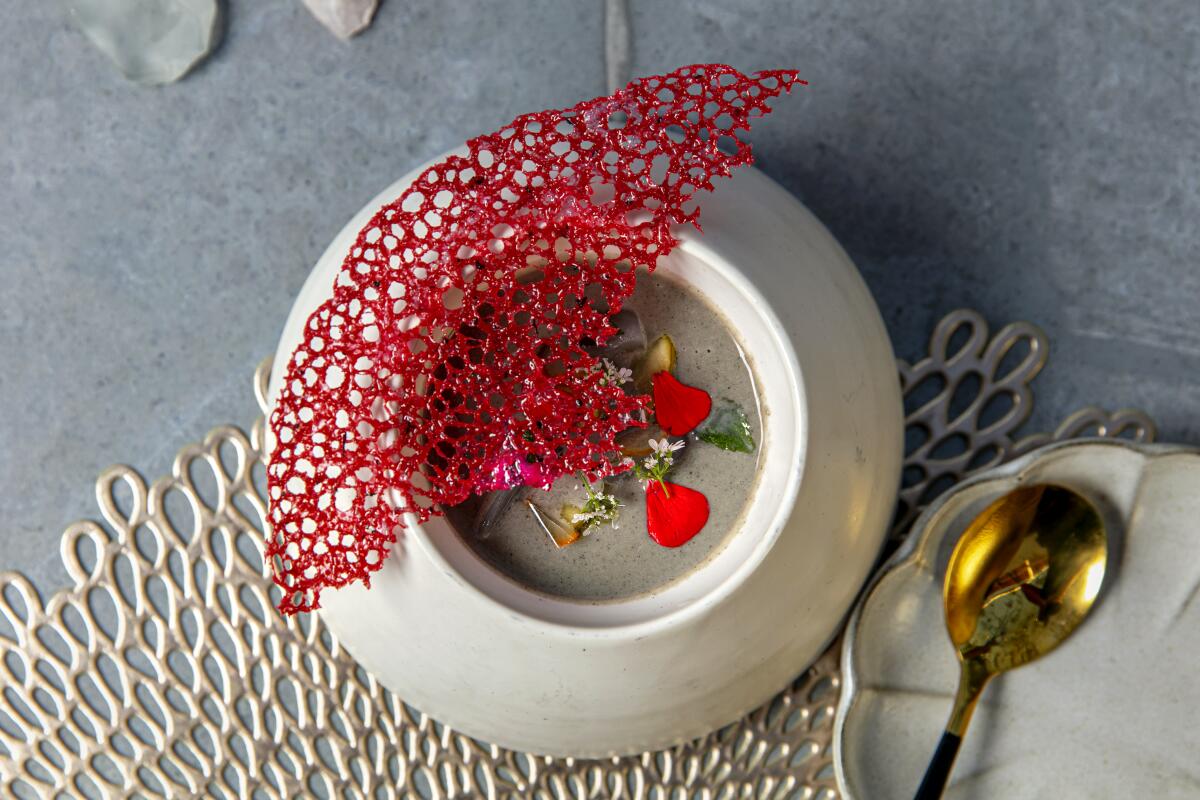
Minh Phan says a collaboration dinner with Niki Nakayama and Carole Iida-Nakayama of n/naka, one of the most lauded kaiseki menus in the country, inspired her to open Phenakite, her tasting menu restaurant in Hollywood. Known best for Porridge and Puffs, her porridge-centric restaurant in Filipinotown, Phan opened Phenakite just as the pandemic was wreaking havoc in late 2020, at a time when people were hungry for any form of comfort and connection.
âPeople are craving culture and experiences now more than ever,â Phan said. âAnd one that delivers not only emotionally, cerebrally but physically and very few art forms deliver on all three levels and communally too.â
Tired of packaging her food in takeout boxes, the new format of 10-plus courses afforded more of a dialogue for Phan to forge a connection with diners and her staff. In the middle of the Second Home communal workspace, which serves as Phenakiteâs lush outdoor dining room, Phanâs cooking staff serves dishes directly to diners.
The menu changes often. If youâre lucky, youâll be presented with a bowl of black vichyssoise studded with pickled green figs and fermented plums. Or a rich porridge fortified with brown butter and abalone liver. Or maybe a savory mochi with Sho Chiku Bai sake crammed with lardon, chrysanthemum and sweet snap peas.
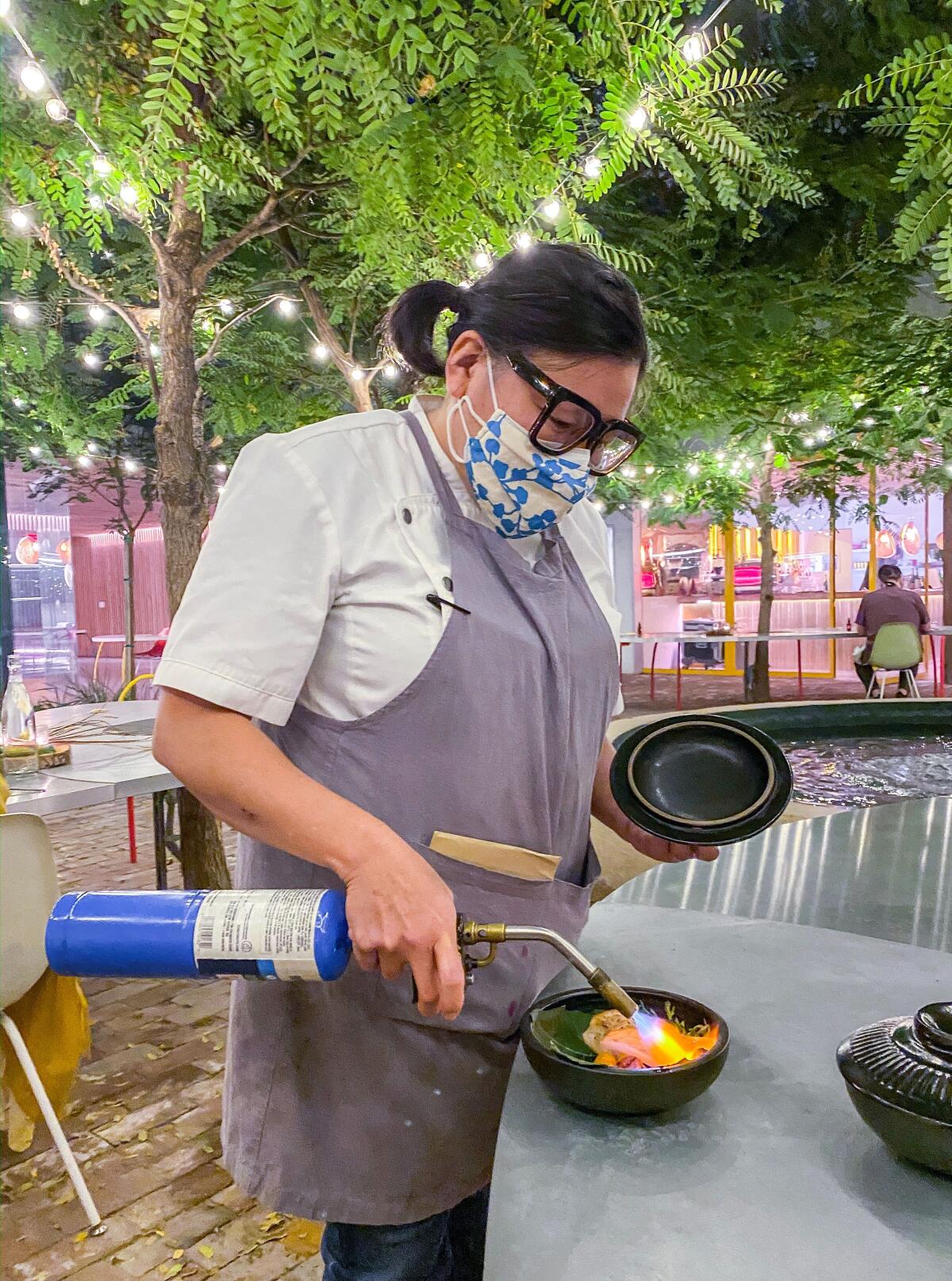
The desire to relay a personal journey through food was what propelled Army veteran Melissa Ortiz to start cooking out of the 350-square-foot kitchen of a coffee shop in Long Beach . Ortiz, who staged at MĂŠlisse and was a sous chef at Connie and Tedâs, signed on as the head chef at Rose Park on Pine in July 2021, after finishing a tour of duty in Afghanistan. She serves a small a la carte menu of vegetable and seafood-centric dishes. In December, she started a monthly tasting menu series with chef friends to develop some dishes and introduce locals to a different style of dining.
âI went to a restaurant in France, and they didnât have a menu, it was just what was available, and I really gravitated towards that because itâs minimal waste and pushes creativity,â Ortiz said. âI want to do a menu in a storytelling way.â
The first in the series was a dinner with Alex Ruperto of Sakura Chocolates. The meal started with masa âchicharronesâ and vinegar followed by fried blue corn mackerel in a tart fermented peach, reaper chile and dashi sauce with pickles; green papaya salad with XO sauce; a take on tortelloni filled with Hokkaido scallops and TransparentSea shrimp in a seafood birria broth; and a sweet sticky rice cake with caramelized coconut curd. The range of dishes allowed Ortiz and Ruperto to share childhood memories. Ruperto is Filipino as are Ortizâs cousins and godfather. The masa chicharrones with vinegar were an homage to eating adobo at Christmas family gatherings. The fried fish with pickles was a nod to Ortizâs Mexican and Portuguese heritage and the fried fish tacos she cooks with her family.
âThese are things that I donât really experience in L.A., and I felt like we needed it,â Ortiz said.
The December menu was $60 a person; this month itâs $100, and Ortiz plans to gradually increase the price tag and transition the monthly series into a weekly offering later this year.
And while $100 per person is by no means inexpensive, itâs a more approachable price than some of the more well-known tasting menus around town. When Vespertine was open for dine-in, dinner was $250 per person, exclusive of tax and service. The current chefâs tasting menu at Providence is $275.
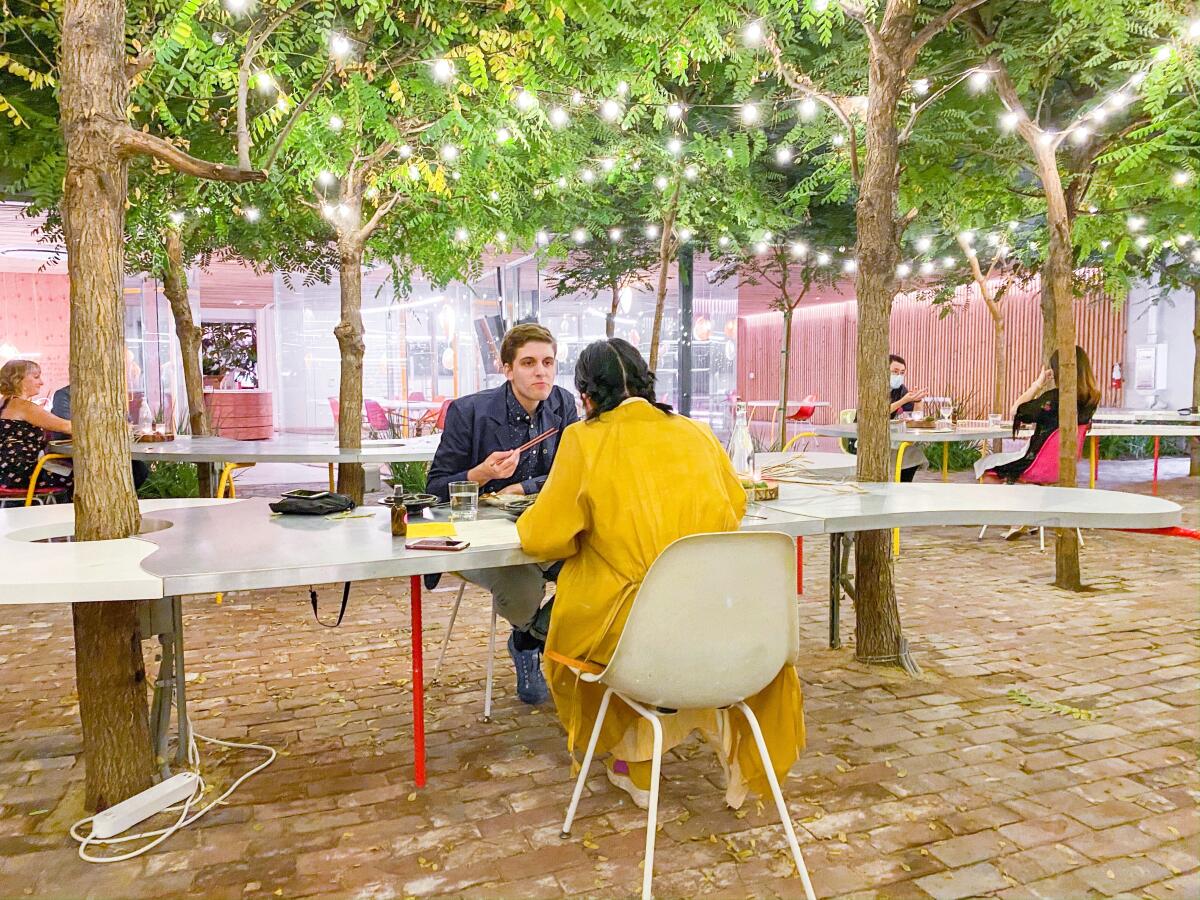
Though Phan said the tasting menu format suits her â110% moreâ than a la carte dining, the $158 cost prompts a certain level of guilt. âAs a community supporter and organizer, I feel really torn,â she said. âThe price point is prohibitive for some people and I miss seeing people every day and feeding them on that level.â
But the new format, serving fewer guests, fewer times a week at a higher price point, created a better work-life balance for Phan and her staff, and that, she said, was something that couldnât be ignored.
For Ryan Wong, chef and co-owner of Needle restaurant in Silverlake, a tasting menu was the only way to stay open during the fall. After offering siu yeh, a series of skewers and snacks, as a once-every-other-week pop-up in the summer of 2020, he decided to transition the restaurant to a $98 siu yeh tasting menu in September after staffing issues.
Wong set up a 3-foot-long yakitori grill called a Konro with binchotan charcoal in front of the restaurant. From there, he constructed a 15-plus-course tasting menu of skewers of chicken thigh with ginger scallion sauce, precisely cut rectangles of zucchini with allium condiment (a burnt onion sauce that in a better world would be sold bottled), rolls of chewy cherfung noodles painted with hoisin, and cylinders of octopus rubbed with curry.
âThere is no guesswork to it,â he said. âWe can prepare what we need to prepare, there is less food waste because we are not over-prepping, and it helps us to manage our workload.â
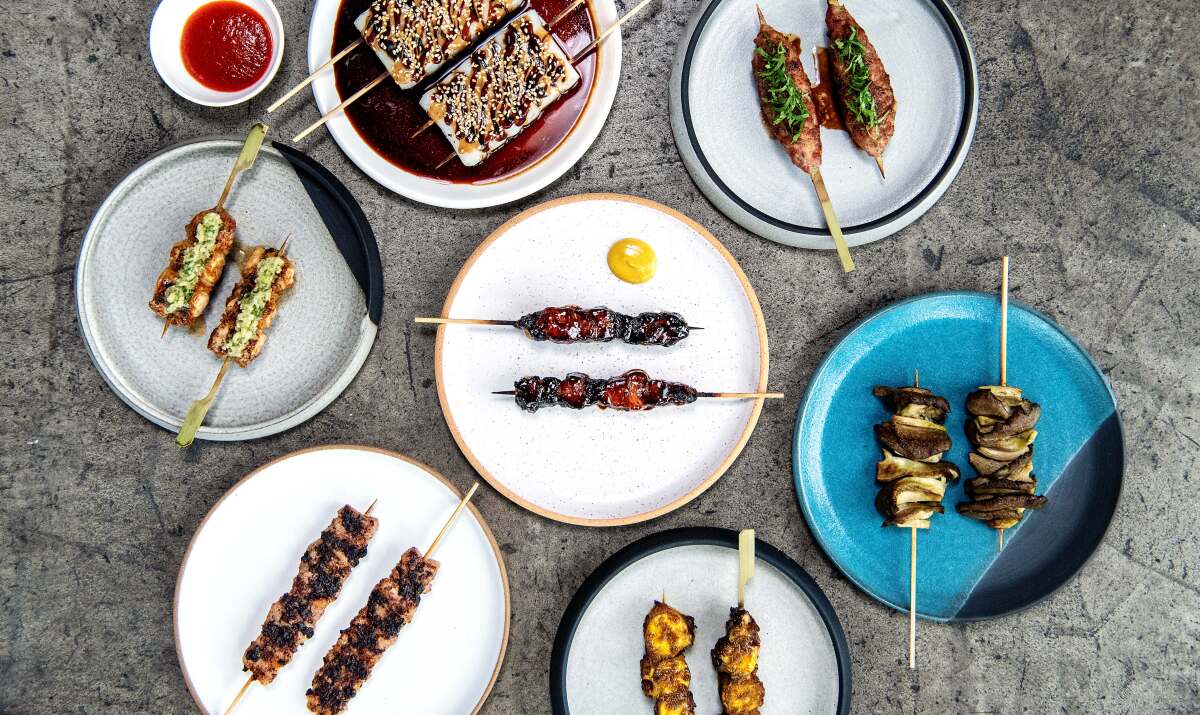
At the time of this writing, Wong had transitioned the restaurant to takeout and patio dining only, putting the siu yeh menu on pause, but there is a possibility heâll bring it back in the future depending on staffing and a host of other factors tied to the pandemic.
Knowing exactly how many diners are coming through the door is what has helped Phillip Frankland Lee to maintain a budding empire of tasting-menu restaurants in the San Fernando Valley, Montecito and Texas. Lee and his wife, pastry chef Margarita Kallas-Lee, are behind Pasta Bar, two Sushi Bar restaurants and Scratch Bar and Kitchen, all located on the second floor of an Encino shopping center.
Pasta is at the center of the tasting menu at Pasta Bar, nigiri is the star at Sushi Bar, and at Scratch Bar, the menu is built around the idea of everything made from scratch, from the bread to the butter.
âWith the way the world is going with rising prices, the economics of a tasting menu are so much more sound,â Lee said. âWe have these 10- to20-seat places that just do tasting menus, and we are able to hit capacity on a daily basis. We know exactly how many people are coming and what they are eating.â
When January 2022 reservations for Pasta Bar were released on Dec. 1, 2021, Lee said they sold out in an hour. Reservations for Scratch Bar and Sushi Bar are just as difficult to obtain. Lee believes at around $150 to $190 a seat, itâs a more approachable entry point to a meal that offers Wagyu, truffles, foie gras, caviar and first-class service.
Itâs also a way to dine somewhere new without experiencing menu anxiety.
âYou always hear, âOh you must have ordered wrong,ââ he said. âIf you donât let them order, they canât order wrong.â
Thatâs the idea behind the tasting menu at Koreatownâs Kinn, the modern Korean restaurant from chef Ki Kim and CEO of In Hospitality Dustin Donghyuk Lee. The two never intended to open a tasting-menu restaurant, but after just one week of service, they ditched the a la carte menu.
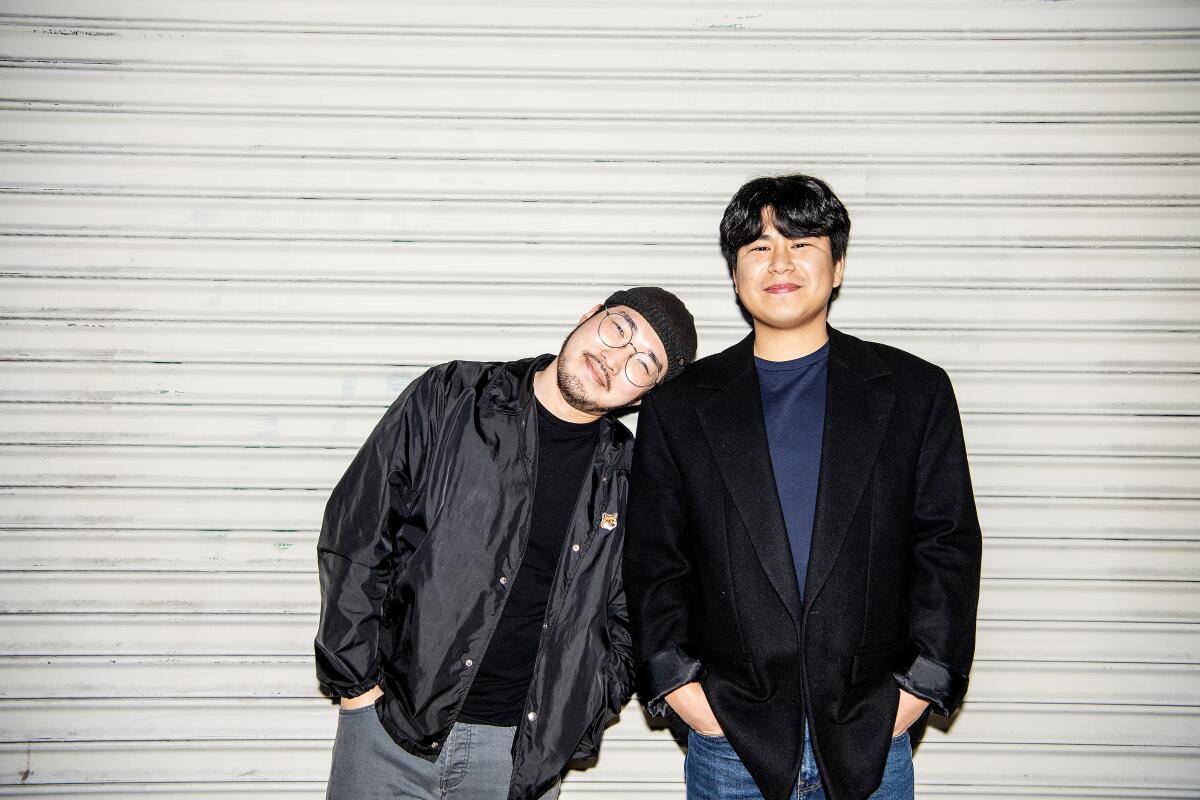
âWe switched the format because we wanted to introduce this concept to people in the way we wanted them to enjoy it,â Kinn said. âA lot of our guests were demanding a tasting menu and asking if we could build the menu for them while we were testing a la carte.â
âI think itâs because they didnât want to take a risk because some are intimidated and others just want to know whatâs good and they donât want to walk out ... missing something,â Donghyuk added.
The menu is informed by nostalgia, with each dish influenced by something Kim ate as a kid or cooked for himself as a young chef. The branzino mulhwe served raw under a disc of blanched sweet potato with corn powder is a nod to Kimâs time as a sushi chef. He seasons Asian pear with citric acid to mimic the flavor of his beloved Sour Patch Kids. The âpig ice creamâ (Iâll refrain from a dish description to keep the mystery alive) is a tribute to Kimâs favorite Korean ice cream treat.
When the restaurant opened in December, the six-course dinner was $65. Now, itâs $72. They may eventually need to raise the price again, but Kim and Donghyuk say they donât want dinner to ever cost more than $100.
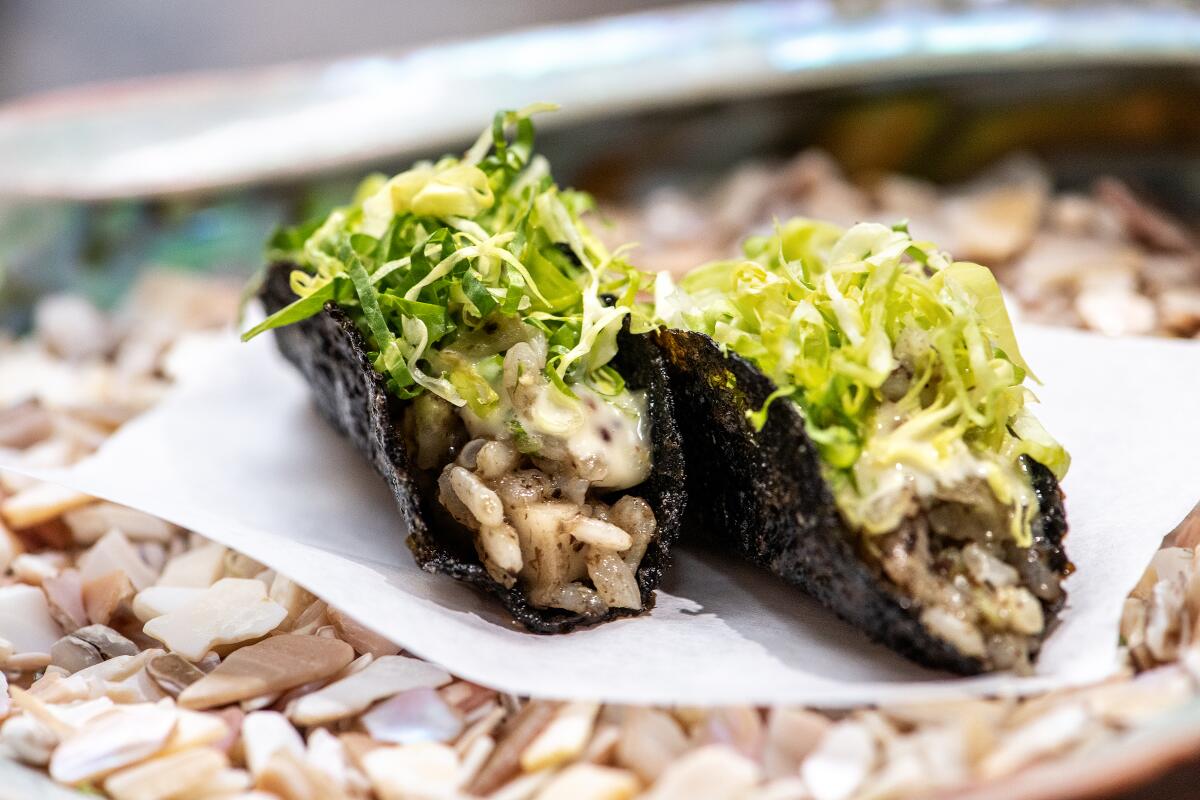
âJust because you get a coursed-out meal doesnât mean itâs pretentious,â Kim said. âI want people to know that this is also Korean food and that itâs edible with wine and that itâs a tasting menu for having a good time. And being able to work with my food cost to execute something special is a challenge but also really fun for me.â
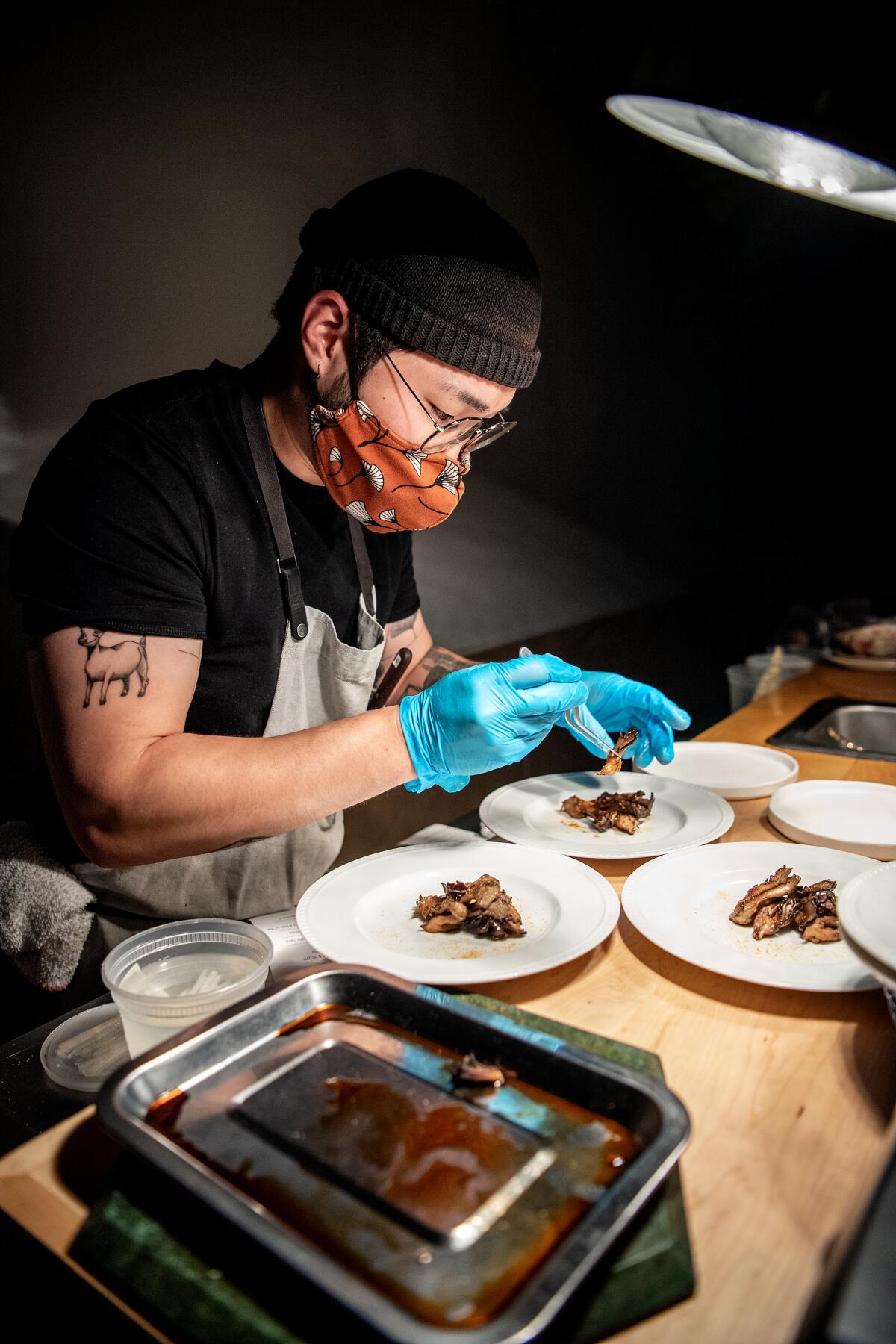
âItâs a really good introduction for customers who might have never been to a tasting menu,â Donghyuk added. âCollege students who want to try this concept can come and itâs much more approachable.â
The 800-square-foot space features a narrow dining room that allows seating along the length of one wall or at the cramped counter that served as the sushi bar for the previous restaurant. Hip-hop music blares and on a recent evening, not a single guest looked to be older than 40.
âL.A. definitely has a vibe and thereâs a demand here,â Kim said. The chef spent years cooking at the Michelin-starred Benu in San Francisco as well as Jungsik and Atomix in New York City before moving to Los Angeles.
The transition to a more casual atmosphere and more affordable checks has meant a shift in diners as well.
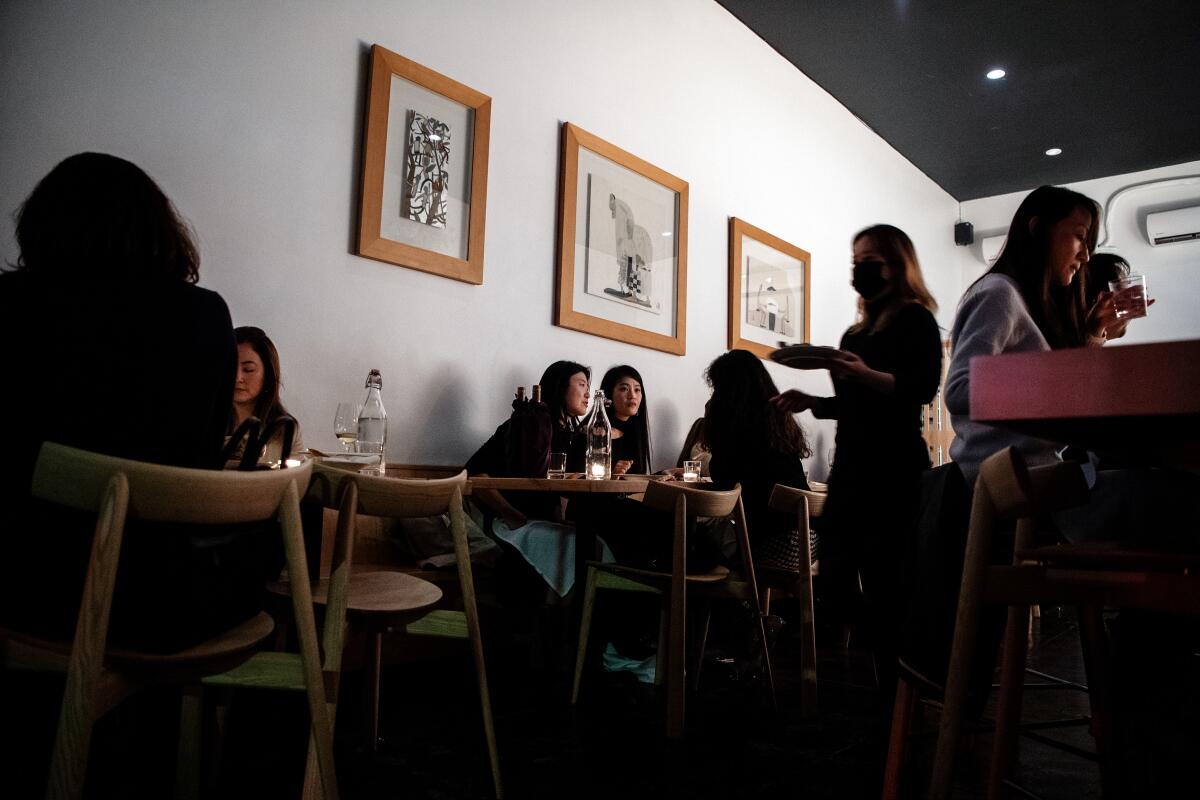
âThe audience is different, the music is different,â Phan said. âYou go to a tasting menu and Kanye [West] is playing and youâre like, âWhat? This is cool.â Itâs not stuffy classical music. Itâs going to be fun. And Iâm glad this is a conversation weâre having during a pandemic.â
This changing of the guard is something MĂŠlisse chef Josiah Citrin says he welcomes for the city. More than a decade ago, Citrin was one of the first Los Angeles chefs to offer a tasting menu. At his two-Michelin-starred restaurant, youâll find more of the traditional, special-occasion experience with innovative French food, dishware that has been meticulously curated for specific dishes and a decidedly fancy air. The chefâs tasting menu at MĂŠlisse is a 2.5-hour theatrical production, presented through seven courses, canapes, amuse-bouches and mignardise. The experience will set you back $295 per person.
âTasting menus have always been exciting for chefs, and this is how you show off,â Citrin said. âYou have chefs like Jon Yao of Kato taking things they learned working in restaurants and rooting them in their culture, and itâs exciting.â
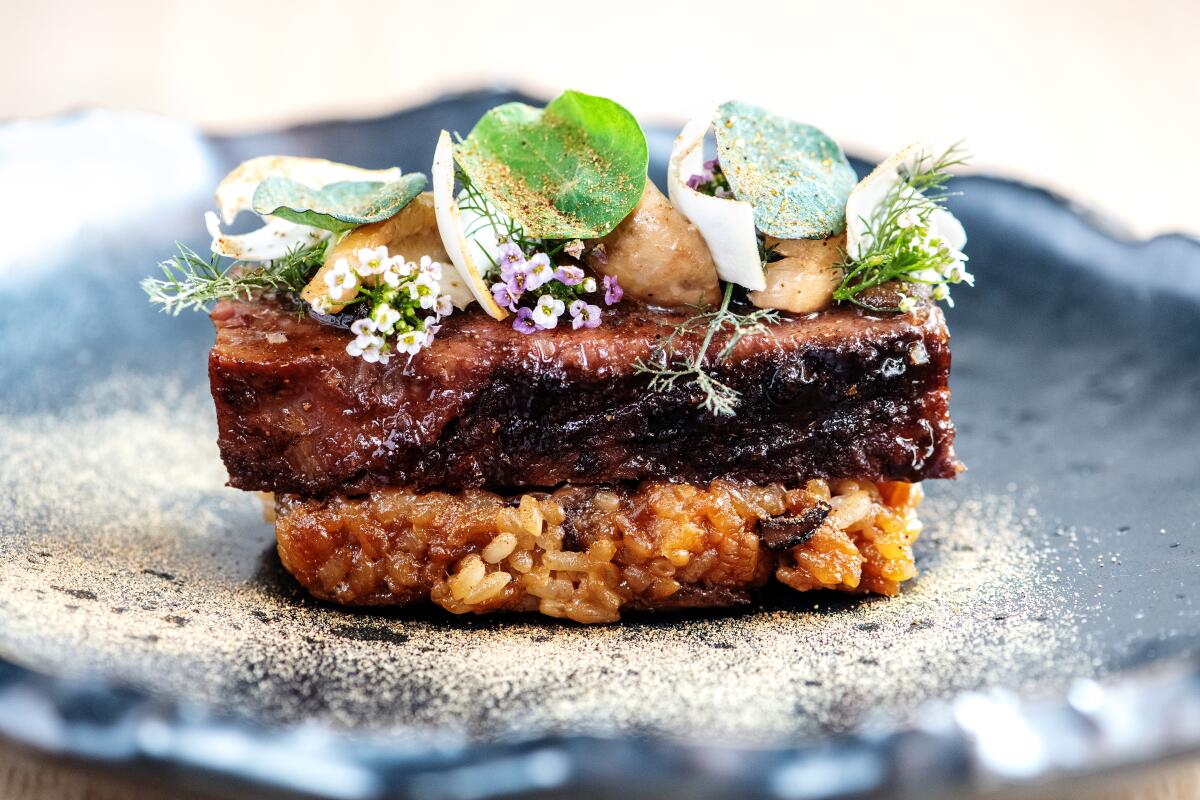
Yao gained national recognition in 2017 with his $55, Taiwanese-inspired tasting menu that he executed out of a modest space near the back of a West Los Angeles strip mall. With its lower check average, informal format and celebration of Taiwanese food, Kato has been a leader for this new tasting-menu movement. He recently relocated to the Row DTLA in the Arts District with a 4,400-square-foot location and a $195-per-person tasting menu.
âThe tasting-menu revolution is a good thing,â Citrin said. âAt the end of the day, whether youâre doing it for survival or because you just like doing it, weâre seeing the evolution of American cuisine in Los Angeles, and itâs fun to watch.â
Restaurants mentioned in this article:
Anajak Thai, 14704 Ventura Blvd., Sherman Oaks, (818) 501-4201, anajakthai.com
Iki Ramen, 740 S. Western Aves #115, Los Angeles, (424) 335-7749, ikiramen.com
Bee Taqueria, 5754 W. Adams Blvd., Los Angeles, (323) 452-9575, instagram.com/beetaqueria
Phenakite, 1370 N. St. Andrews Pl., Los Angeles, (323) 380-8573, porridgeandpuffs.com/phenakite
Rose Park on Pine, 800 Pine Ave., Long Beach, (562) 683-1818, www.instagram.com/roseparkonpine
Needle, 3827 Sunset Blvd., Los Angeles, needlela.com
Scratch Bar & Kitchen, 16101 Ventura Blvd. #255, Encino, (818) 646-6085, scratchrestaurants.com
Pasta Bar, 16101 Ventura Blvd., Encino, (818) 646-6085, scratchrestaurants.com
Sushi Bar, 16101 Ventura Blvd. Suite 242, Encino, (818) 646-6085 scratchrestaurants.com
MĂŠlisse, 1104 Wilshire Blvd., Santa Monica, (310) 395-0881, citrinandmelisse.com
Kato, 777 S Alameda St. Building 1, Suite 114, Los Angeles, (213) 797-5770, katorestaurant.com
More to Read
Eat your way across L.A.
Get our weekly Tasting Notes newsletter for reviews, news and more.
You may occasionally receive promotional content from the Los Angeles Times.











